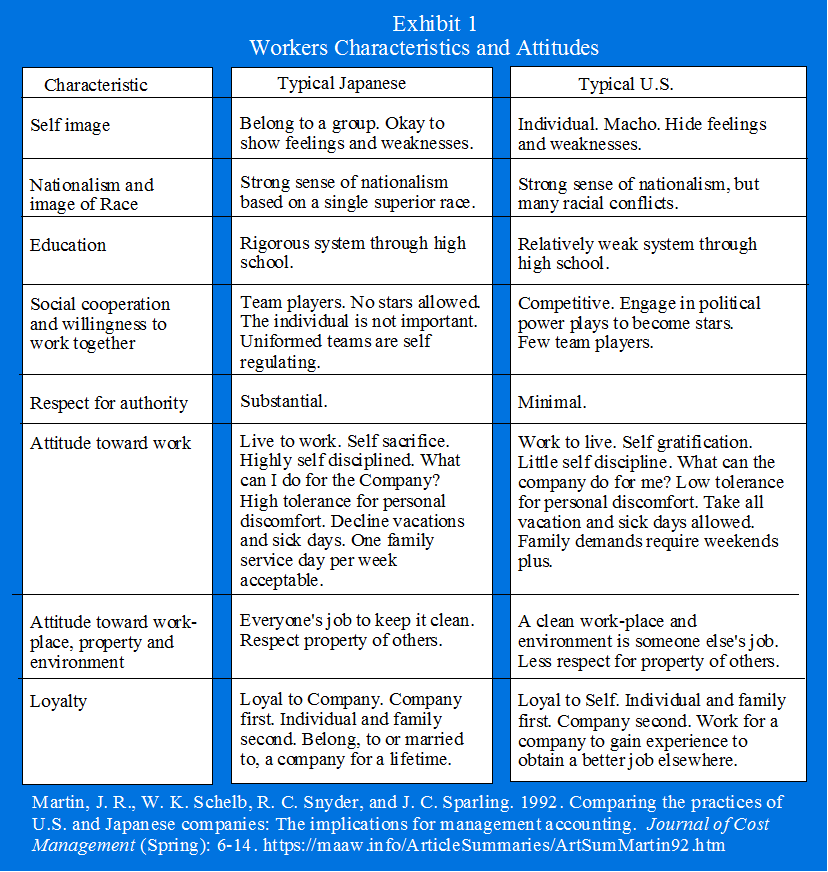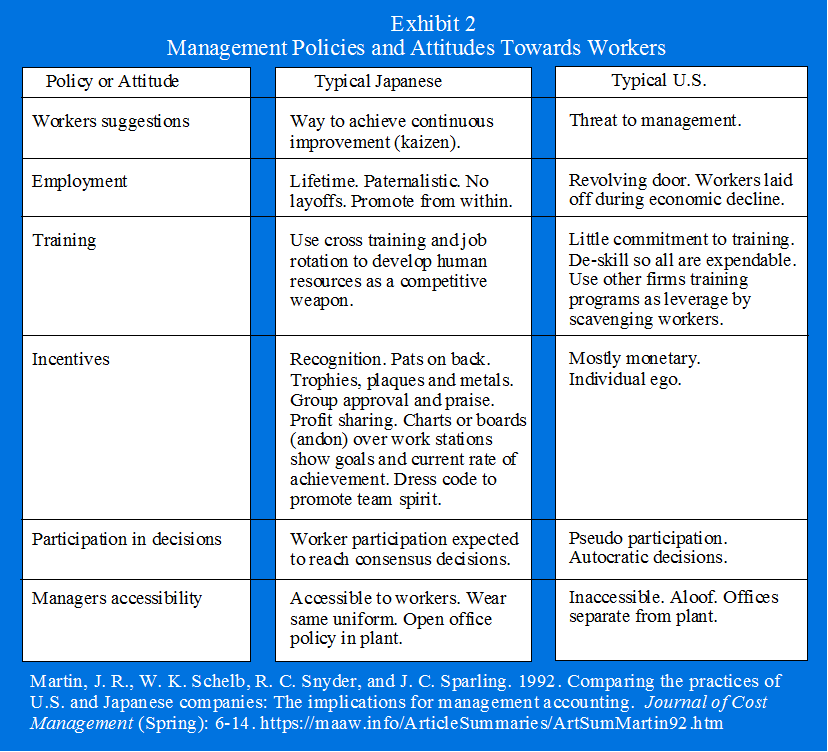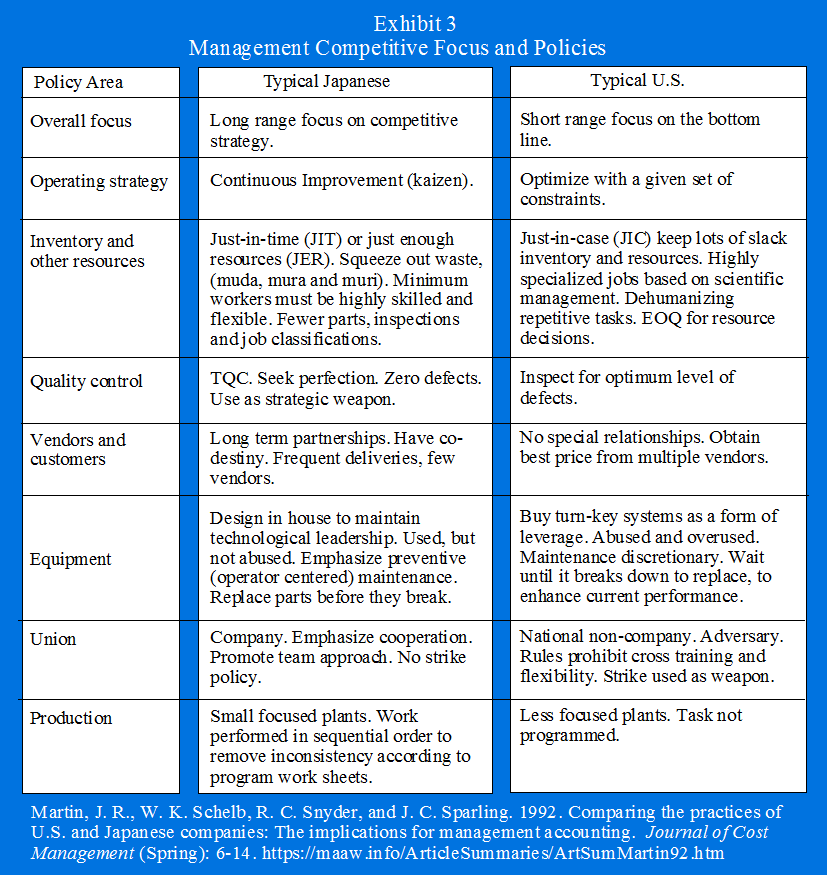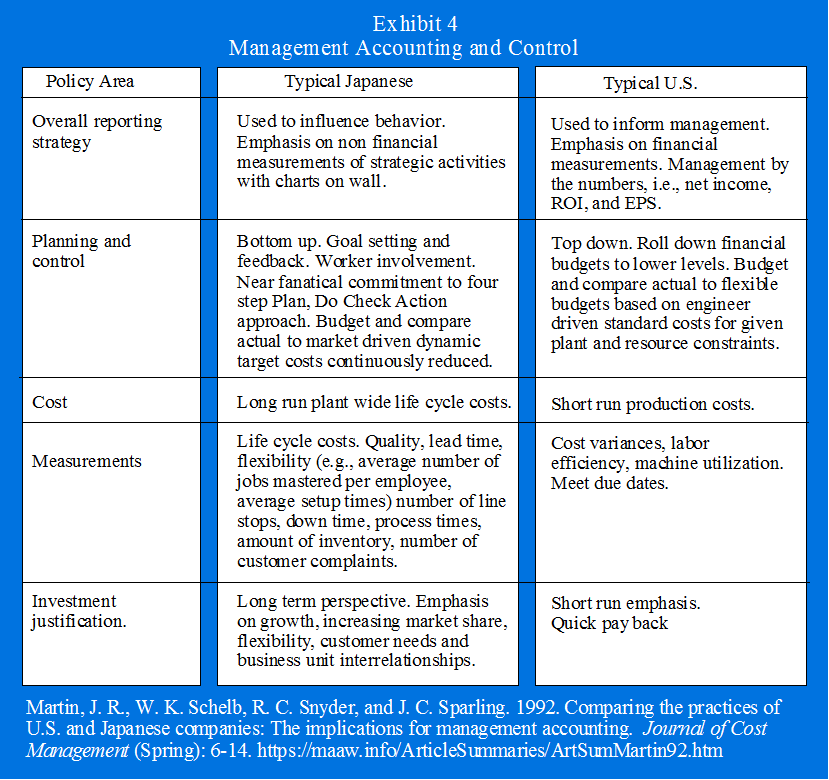
Summary by James R. Martin, Ph.D., CMA
Professor Emeritus, University of South Florida
Framework for MA Main Page | Japanese Management Main Page |
CAM-I Main Page
Many researchers have studied the Japanese people and Japanese management practices. We summarized that literature up to 1991. Our purpose was to compare U.S. and Japanese workers and management practices to show how the observed differences are linked to the need for different management accounting and control systems. The article is divided into four main sections as indicated below. Each section includes a table comparison that did not appear in the published version of the article. Much of this summary was taken from an earlier version of the paper that I presented at the Western Regional Meeting of the American Accounting Association in 1991.
1. Characteristics and attitudes of workers
2. Management attitudes and policies toward workers
3. Competitive focus of management and management policies
4. Management accounting and control
Workers Characteristics and Attitudes
Although it is somewhat presumptuous to generalize about the characteristics and attitudes of millions of people, some rather basic and important differences between the Japanese and U.S. workers appear to exist.
First, the Japanese concept of self is very different from the American view. In Japan, each person is believed to possess a unique spirit, soul, mind and heart, but the self concept is considered an impediment to growth. The Japanese establish identities that incorporate friends, relatives and coworkers in an open way to share feelings and improve on weaknesses. The workers relationship within the work group is very important psychologically. On the other hand, U.S. workers are for the most part individualist and strive to appear as macho and self sufficient as possible.
The Japanese also have a very strong sense of nationalism and believe that they are superior to all other races. Although Americans also have a strong sense of national pride, there are many racial conflicts in the U.S. that reduce our ability to work together. The education systems in the two countries are also very different. While the Japanese have a very rigorous system through high school, it is possible for a student to graduate from high school in the U.S. without being able to read and write adequately. These differences may have serious implications for U.S. firms seeking entry level workers.
Perhaps the fact that the Japanese are all from a single race and have an entirely different concept of self explains why, at least to some extent, they appear to be more cooperative and willing to work together in teams. To maintain and strengthen work group relationships, Japanese workers spend a considerable amount of time socializing after work. Japanese children wear uniforms to school and this is continued with company uniforms later in life. This willingness to dress alike and act alike is very different from the typical American who is taught to be competitive and engage in various political power plays to take credit for accomplishments and achieve star status.
Japanese workers also appear to have more respect for authority than their U.S. counterparts, as well as an entirely different attitude towards work. The Japanese apparently live to work and are willing to sacrifice their personal lives for the company. They are more tolerant of long hours and uncomfortable working conditions than U.S. workers, frequently work when they are sick and decline vacation time to avoid reducing productivity. One family service day per week seems to be adequate time for family matters. U.S. workers are more inclined to work to live, or for self gratification, have less self discipline and less tolerance for discomfort. In addition, American workers expect to spend more time with their families and obtain a variety of perquisites that have been won in hard fought management/union confrontations over the past several years. We do not mean to imply that these expectations are unreasonable, only that they are different from those of the typical Japanese worker.
The Japanese also keep their cities and factories crime free and spotless, where trash, graffiti and cigarette butts are conspicuously absent. Each worker keeps his or her work station clean. Even taxi drivers wear white gloves and are rather unforgiving if a patron soils the cab. Crime rates in Japan are very low relative to the U.S. where cities and factories are notorious for crime and garbage.
Japanese workers are also more loyal to their employers than U.S. workers and in many cases are essentially married to the company for a lifetime. American workers, on the other hand, tend to be loyal to themselves and sometimes their families and frequently use a company only to gain enough experience to move to a better paying position at another firm.

Management Attitudes and Policies Towards Workers
Japanese workers are expected to provide suggestions for improving their own operating efficiency, as well as the overall productivity of the organization. The rational for this expectation is that it promotes continuous improvement. Although suggestion systems are also used in the U.S., employee suggestions are viewed more as a threat to management. U.S. employees who constantly recommend changes are likely to be labeled as trouble makers.
Japanese managers seem to view the company's employees as their most important resources. To develop these resources to the fullest potential, the typical Japanese company offers lifetime employment, promotions from within, considerable cross training and job rotation, and frequently a no layoff policy. In this way the Japanese use human resources as a competitive weapon.
Employment in the U.S., however is somewhat analogous to a revolving door. Workers are routinely laid-off during economic down turns and there appears to be little commitment to training. The scientific management approach used in the U.S. is based on a system of specialization where each worker performs a few repetitive tasks. In this approach, workers are de-skilled to such a low level that all are expendable. Neither management nor the workers trust each other, thus the process feeds on itself. U.S. managers appear to use a type of short run leverage in the area of human resources. Scavenging trained workers from other firms, the scavenger uses other firms' investments in human resources to achieve results.
The typical Japanese incentive system also appears to be quite different from U.S. systems. The Japanese place considerable emphasis on employee recognition including simple pats on the back, business cards for all workers, trophies, company pins, plaques, medals, group approval, and charts over work stations to show goals and achievements. Although there are some small cash awards for suggestions and employee profit sharing systems, Japanese workers seem to respond reasonably well to the psychological incentives. American incentive systems are for the most part monetary systems based on salary increases, promotions and bonuses.
Japanese companies also have worker participation systems that are very different, at least conceptually, from their U.S. counterparts. Workers are expected to participate in consensus decisions where the group attempts to come to a unanimous decision. The final decision is made by the group leader, and all members of the group are expected to accept it as their own decision. Voting is not allowed however, because voting denotes winners and losers. In the consensus system, there are, supposedly, only winners. U.S. workers do not participate in work related decisions to the same extent as Japanese workers and may frequently provide only pseudo participation in decision making. Most work related decisions are made by autocratic supervisors. When group or committee decisions are made, the democratic voting process prevails with the inevitable winners and losers.
Another difference between Japanese and U.S. companies is the accessibility of managers to workers. In Japanese factories, managers tend to wear the same uniforms as line workers and work in offices that are inside the factory and open to workers. U.S. managers, above the supervisory level, are generally inaccessible to workers and are perceived by workers as aloof. American managers work in air conditioned offices separated from the factory by long infrequently used corridors.

Management Competitive Focus and Policies
The overall focus of Japanese management is on the firm's long run competitive strategy as opposed to U.S. managers who appear to be more concerned with short run financial performance. Perhaps, to some extent, this difference may be explained by the variations in reporting requirements in the two countries. For example, Japanese companies are not required to submit quarterly reports to stockholders. However, there are other more fundamental differences in the way the Japanese manage. In fact, the concept underlying the very foundation of Japanese management is substantially different from the traditional U.S. concept of management.
Japanese management policies and techniques are grounded by the concept of continuous improvement (kaizen). On the other hand, traditional American management practices are derived from the concept of optimization which grew out of the scientific management era of the early 1900's and developments in the operations research discipline in the 1950's. Understanding the differences between these two concepts is extremely important because they have a pervasive influence on the design and implementation of every management policy, technique, performance measurement system and decision. The fundamental difference is that management based on the concept of continuous improvement is dynamic, i.e., constantly seeking perfection by removing constraints, while the concept of optimization is static, i.e., find the optimal solution given a set of constraints.
In the area of resource management, the Japanese use the sub-concept of just-enough-resources (JER), commonly referred to as just-in-time (JIT or Kanban) for inventory. The idea is to squeeze out three kinds of waste including "muda" which represents waste caused by idle resources and unnecessary motions (e.g., looking for misplaced tools), "mura" which is waste caused by the irregular or inconsistent use of a resource, and "muri", which is waste caused by placing excessive demands on resources. In the JER approach, all resources are minimized, including inventory, workers, equipment, job classifications, and product parts and subassemblies.
Traditional U.S. managers use an entirely different concept that some authors have referred to as just-in-case (JIC). In the JIC approach to resource management, large amounts of slack resources are kept on hand to guard against contingencies such as late deliveries, poor quality, production bottlenecks and fluctuations in demand. Of course, these concepts have some very important implications for the resources themselves. JER and JIT require highly skilled and highly dedicated cross trained workers, as well as high quality raw materials and well maintained equipment. In the JIC environment, high skill levels and high quality materials and equipment are not as critical. For example, in the area of inventory and production lot sizes, the idea, according to the applicable sub-concept of optimization, is to find the economic order quantity or batch size (EOQ) that will minimize the conflicting costs involved in the decision, (e.g., ordering and carrying costs or setup and carrying costs).
To promote high quality, the Japanese use the sub-concepts of total quality control (TQC), or zero defects, and quality at the source (jidoka). Jidoka places emphasis on correcting problems when and where they occur. Implementing these quality concepts obviously requires dedicated workers. High quality also requires close relationships with vendors to insure that the firm receives defect-free raw materials and close relationships with customers to insure that customers' specifications are met. The Japanese view this as a co-destiny relationship with their vendors and customers. These partnerships provide linkages across the entire value chain that lead to fewer, more reliable vendors and more frequent deliveries from vendors, as well as to customers. U.S. firms have traditionally used multiple vendors and placed more emphasis on price variances and quantity discounts. Thus, quality has not received the highest priority. Determining the optimum level of quality has been the norm for American firms. This is evident when one considers the traditional standard cost systems so common in U.S. accounting textbooks and manufacturing practice. Although there appears to be a new emphasis on quality in the U.S., the newer American approach is still grounded in optimization theory. In this new approach, which has been referred to as the "Optimal Economic Conformance Model", prevention and appraisal costs are balanced against internal and external failure costs. This is fundamentally different from the dynamic TQC approach advocated by Deming in which a company cannot have too much quality.
The continuous improvement concept also affects Japanese decisions in the area of equipment acquisition and utilization. Many Japanese companies tend to design and carefully maintain their own equipment with preventive maintenance centered at the operator level. Equipment parts are replaced before they break to prevent idle time (muda) from occurring during production runs. In house equipment development also promotes innovation and allows the Japanese to maintain technological leadership. U.S. firms, on the other hand, are somewhat more inclined to buy turn-key systems and replace parts only when they break down. In the Japanese JER or JIT system, maintenance is mandatory, not a discretionary decision to be used for shifting costs from current to future periods. It is also important to note that buying production equipment from others is another form of leverage that provides certain short term benefits to the purchaser. However, the disadvantage of this policy is the higher long term risk of losing market share to the technological leaders. Buying technology off the shelf prevents the firm from competing on the basis of product differentiation, or innovation, since competitors will have access to the same technology.
The Japanese union also plays an important part in supporting the continuous improvement concept and it's many related sub-concepts. In Japan, unions are company sponsored and are more of an extension of management than a separate entity established to represent workers. The union typically works to promote teamwork by supporting a small number of job classifications, considerable cross training and a no strike policy. U.S. union policies conflict with the JER and JIT concepts by requiring a large number of job classifications that prohibit cross training. The American union has an adversary relationship with management and uses the strike as a weapon to achieve higher wages and benefits for union members.
Another way that Japanese and traditional U.S. management practices differ is in the area of production. The Japanese tend to build smaller more focused plants where work is performed in sequential order to remove inconsistencies (mura) according to program work sheets. The idea is to remove wasted or unnecessary motions to improve efficiency. U.S. plants tend to be larger and less focused where American workers generally perform the work in the order of their preference.

Management Accounting and Control
Japanese accounting and control systems are subservient to corporate strategy and are essentially used to influence behavior. In the U.S., on the other hand, accounting and control systems have been used mainly to inform management about the company's performance. In Japan, planning and control is based on a bottom up approach where workers and lower level managers participate in developing goals and receive considerable feedback as the plans are implemented. In the U.S., planning and control is based on a top down approach where the financial budget is rolled down into the organization. The view that the Japanese are highly committed to planning and feedback is supported by their almost fanatical use of a system called Plan-Do-Check-Action (PDCA). In this system, the plan step includes identifying the problem and the underlying cause, plus developing a plan for the problem's solution. The Do step involves a trial run to determine if the plan works. In the Check step, the trial run is evaluated and revisions are made if necessary. The final Action step is to implement the plan. The PDCA approach is a never ending activity for the Japanese who are very meticulous about providing documentation for nearly every decision.
The Japanese compare actual costs to market driven target costs. Target costs are established somewhere between standard costs and allowable costs which are determined by subtracting a target profit margin from the target price. The target price is the price that would provide the company with a competitive edge in the market. This approach is dynamic since the target costs are continuously reduced, both during and after the design stage to promote continuous improvement. The traditional American approach is to compare actual costs with flexible budgets based on engineer driven standard costs. However, standard costs are based on the static optimization concept where standards are set based on the current plant and resource constraints. The emphasis is on achieving the internal standard rather than continuously reducing costs to achieve the external goal.
The Japanese also use a long run life cycle approach to product cost and place a substantial amount of emphasis on non financial measures of performance such as quality, lead time and flexibility. Some of the more specific measurements include: the average number of jobs mastered per employee, average setup times, number of line stops, down time, process times, amount of inventory and number of customer complaints. U.S. firms have traditionally placed more emphasis on short run variances from standard costs, with considerable attention directed to labor efficiency measurements. However, the standard cost control concept has been criticized because the traditional variances can motivate managers to act in ways that reduce, rather than enhance the company's competitive position. Thus, the standard cost methodology appears to be inconsistent with the concept of continuous improvement.
Japanese investment justification decisions are based on a long term perspective where emphasis is placed on growth, increasing market share, flexibility and customer needs. Decisions are made using the Namawashi approach which includes more involvement by lower level managers. When compared to the Japanese, U.S. companies seem to place more emphasis on the short run financial effects of investment decisions and quick paybacks. Thus, traditional American investment decision techniques have not adequately considered the intangible factors involved that affect the company's long run competitive position. The Japanese also appear to be in a better position to exploit interrelationships among business units to achieve, or maintain, a competitive advantage. A horizontal strategy that coordinates investment decisions across a large group of interrelated divisions, may well produce greater corporate benefits in the long run, than a series of independent investment decisions made at the unit level.

How U.S. Firms Are Becoming World Class Competitors
The comparison of the U.S. and Japanese workers and management attitudes and policies paints a rather bleak picture of America's position and potential in the global economy. However, it should be emphasized that the summary comparisons provided above are based on a great many generalizations that do not apply equally to all workers and companies. Many American companies began to develop a different strategic mind-set in the 1980's and currently use many of the concepts previously attributed exclusively to the Japanese. One of the most notable examples of the changes taking place in the concepts underlying U.S. management practices is provided by the CAM-I cost management systems (CMS) conceptual design document. The CAM-I publication embraces the overall concept of continuous improvement and most of the accompanying sub-concepts including just-in-time, total quality control, life cycle costing and a portfolio approach to investment management. The CMS conceptual design was developed by a large group of individuals employed by CAM-I's sponsoring firms and organizations who continue to work together to develop better cost management and performance systems.
__________________________________________________
Related summaries:
Blake, R. R. and J. S. Moulton. 1962. The managerial grid. Advanced Management Office Executive 1(9). (The Grid).
Cooper, R. and C. A. Raiborn. 1995. Finding the missing pieces in Japanese cost management systems. Advances in Management Accounting (4): 87-102. (Summary).
Crawford, R. J. 1998. Reinterpreting the Japanese economic miracle. Harvard Business Review (January-February): 179-184. (Summary).
Cushing, B. E., editor. 1987. Accounting and Culture: Plenary Session Papers and Discussants' Comments from the 1986 Annual Meeting of the American Accounting Association. American Accounting Association. (Summary).
Deming, W. E. 1993. The New Economics For Industry, Government & Education. Cambridge: Massachusetts Institute of Technology Center for Advanced Engineering Study. In the preface Deming states that the present style of management is a modern invention and represents "a prison created by the way in which people interact." The present system includes competition between people, teams, departments, divisions, students, schools and universities. Although economists have taught that competition will solve our problems, we now know that competition is destructive. A better approach is for everyone to work together as a system. The solution to problems comes from cooperation, not competition. (Summary).
Dillon, L. 1990. Can Japanese methods be applied in the western workplace? Quality Progress (October): 27-30. (Summary).
Hayes, R. H. 1981. Why Japanese Factories Work, Harvard Business Review (July-August): 57- 66. (Summary).
Hiromoto, T. 1988. Another hidden edge: Japanese management accounting. Harvard Business Review (July-August): 22-25. (Summary).
Howell, R. and M. Sakurai. 1992. Management Accounting (and other) Lessons from the Japanese. Management Accounting (December): 28-34. (Summary).
Imai, M. 1986. Kaizen: The Key To Japan's Competitive Success. New York: McGraw-Hill Publishing Company. (Summary).
Johnson, D. W., G. Maruyama, R. Johnson, D. Nelson and L. Skon. 1981. Effects of cooperative, competitive, and individualistic goal structures on achievement: A meta-analysis. Psychological Bulletin (89): 47-62. (Summary).
Kapanowski, G. 2016. Lean fundamentals for accountants. Cost Management (January/February): 5-14. (Summary).
Maginnis, M. A. and G. Uminger. 2018. Management accounting in a true lean (TPS) environment. Cost Management (January/February): 27-35. (Summary).
Martin, J. R. Not dated. Lean concepts and terms. Management And Accounting Web. Lean requires cultural change. Extreme individualism must be replaced by more collectivist or cooperative behavior. Lean behavior is required from everyone in the organization as everyone understands his or her role. Workers in lean environments know who their customers are, both internal and external, and place emphasis on customer satisfaction, a clean, safe, and orderly environment with everything in its place, as well as teamwork, cooperation in problem solving, and employee empowerment. Lean Concepts and Terms Summary
Martin, J. R. Not dated. Profit Beyond Measure graphics and notes. Management And Accounting Web. Johnson Broms Graphics Notes
Martin, J. R. Not dated. What is lean accounting? Management And Accounting Web. Lean Accounting
McGregor, D. M. 1957. The human side of enterprise. Management Review (November): 22-28. Reprinted from the Proceedings of the Fifth Anniversary Convocation of the School of Industrial Management, MIT, April 9, 1957. (Summary).
O'Clock, P. and K. Devine. 2003. The role of strategy and culture in the performance evaluation of international strategic business units. Management Accounting Quarterly (Winter): 18-26. (Summary).
Ouchi, W. G. 1979. A Conceptual Framework for the Design of Organizational Control Mechanisms. Management Science (September): 833-848. (Summary 2).
Ouchi, W. G. and A. M. Jaeger. 1978. Type Z organization: Stability in the midst of mobility. Academy of Management Review. (April): 305- 314. (Summary).
Porter, M. E., M. Sakakibara and H. Takeuchi. 2000. Can Japan Compete? (Perseus). (Summary).
Sakurai, M. 1995. Past and future of Japanese management accounting. Journal of Cost Management (Fall): 21-30. (Summary).
Spear, S. and H. K. Bowen. 1999. Decoding the DNA of the Toyota production system. Harvard Business Review (September-October): 97-106. (Summary).
Spear, S. J. 2004. Learning to lead at Toyota. Harvard Business Review (May): 78-86. (Summary).
Takeuchi, H. 1981. Productivity: Learning from the Japanese. California Management Review (Summer): 5-18. (Summary).
Tanaka, T. 1993. Target costing at Toyota. Journal of Cost Management (Spring): 4-11. (Summary).
Tanaka, T. 1994. Kaizen budgeting: Toyota's cost-control system under TQC. Journal of Cost Management (Fall): 56-62. (Summary).
Toyota Public Affairs Division and Operations Management Consulting Division. 1998. The Toyota Production System: Leaner Manufacturing for a Greener Planet. The Toyota Motor Corporation. (Summary).